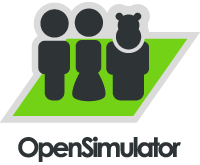OpenSimulator
This article has multiple issues. Please help improve it or discuss these issues on the talk page. (Learn how and when to remove these messages)
|
 | |
| Stable release | 0.9.2.2
/ March 29, 2023[1] |
|---|---|
| Operating system | Cross-platform |
| Type | Server |
| License | BSD |
| Website | opensimulator |
| Filename extension |
.iar |
|---|---|
| UTI conformation | application/tar |
| Developed by | OpenSimulator |
| Type of format | File archiver |
| Filename extension |
.oar |
|---|---|
| Internet media type |
application/oar |
| UTI conformation | application/tar |
| Developed by | OpenSimulator |
| Type of format | File archiver |
OpenSimulator is an open-source server platform originally launched in 2007 for hosting virtual worlds and metaverse environments. It is largely compatible with the virtual world Second Life but full compatibility is not a design goal.
Features
[edit]OpenSimulator is written in C# and is designed to be easily expanded through the use of plugin modules. OpenSimulator can operate in one of two modes: standalone or grid mode. In standalone mode, a single process handles the entire simulation. In grid mode, various aspects of the simulation are separated among multiple processes, which can exist on different machines.[2]
OpenSimulator uses loadable modules for most of its functionality. These loadable modules can be independently developed to add functionality to the server.[3]
OpenSimulator currently uses a modified Second Life protocol for client to server communication, and requires retrofitting to a suitable virtual world viewer (client) in order to connect. Interoperability with Second Life protocols was initially a design goal.[4] During the OpenSimulator Community Conference 2018, the core developers announced they may not always seek to maintain compatibility with Linden Lab's Second Life Protocols, and may change or add facilities in line with differing aims.[citation needed]
OpenSim has a number of features not available in Second Life. These include virtual world content (OAR) and avatar inventory (IAR) save and load capabilities, extensions to the scripting language that enable saving and retrieval of text data to avatar inventory in notecard format and the creation and management of non-player characters (NPCs).[citation needed]
OpenSim also uses an architecture known as "Hypergrid", which allows users to teleport between multiple OpenSim-based virtual worlds by providing a hyperlinked map which indexes public grids.[5] This allows for public grids to retain teleportation links to each other without having to be on the same grid. The number of hypergrid-enabled OpenSimulator grids fluctuates. As of February 2023, there were just over 400 active hypergrid-enabled services.[citation needed]
See also
[edit]- Open Wonderland – A Java-based open source 3D toolkit for creating collaborative virtual worlds.
- IBM Virtual Universe Community – One of the largest contributors to the OpenSim project.
- Open Cobalt – A decentralized open source virtual world architecture.
- High Fidelity Inc - A "next-generation" social virtual reality platform.
- JanusVR - Immersive web browsing software support VR and loading worlds via web content
References
[edit]- ^ "Download - Current release". OpenSimulator. 29 March 2023. Retrieved 10 May 2023.
- ^ "Configuration". OpenSimulator. 21 June 2021. Retrieved 2 December 2022.
- ^ "Getting Started with Region Modules". OpenSimulator. 12 March 2012. Retrieved 2 December 2022.
- ^ White, Brian (11 August 2008). "A Bridge between Virtual Worlds: Second Life's new program links virtual environments". Technology Review. MIT. ISSN 1099-274X. Archived from the original on 20 May 2022. Retrieved 2 December 2022.
- ^ "Hypergrid". OpenSimulator. 24 December 2021. Retrieved 2 December 2022.
Further reading
[edit]- Lin, Tsun-Ju; Lan, Yu-Ju (October 2015). "Language Learning in Virtual Reality Environments: Past, Present, and Future". Educational Technology & Society. 18 (4): 486–497. eISSN 1436-4522. ISSN 1176-3647. JSTOR jeductechsoci.18.4.486. S2CID 43324220.
